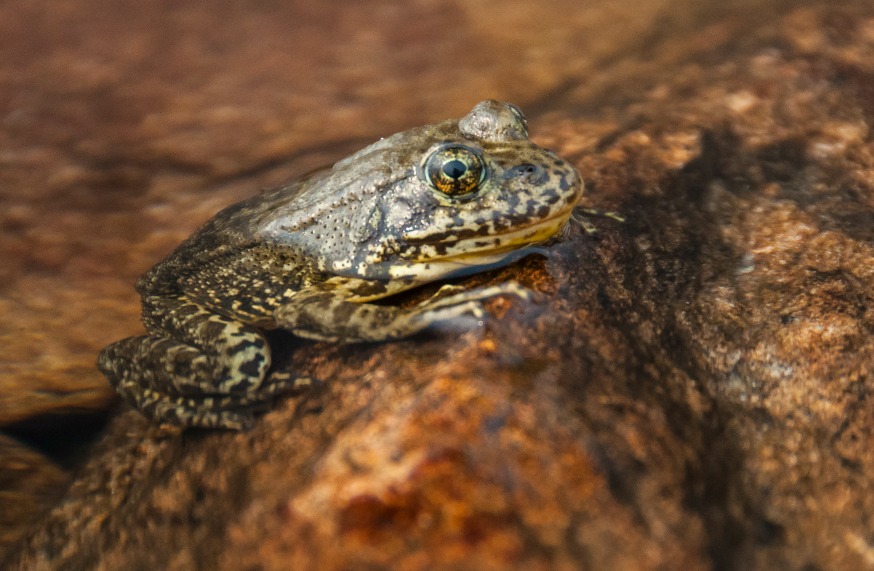SEQUOIA AND KINGS CANYON NATIONAL PARKS, CALIFORNIA—Work to restore endangered frogs to high elevation aquatic ecosystems will be continuing under a newly approved plan. The approval allows the National Park Service to remove nonnative fish from a number of high elevation ponds, streams, and lakes in the parks. The presence of nonnative trout, which were first introduced in the late 1800s for fishing, have significantly altered these ecosystems. Under the plan, nonnative trout will be removed from up to 85 bodies of water and 31 miles of streams, plus adjacent habitat if necessary. In all, there are 550 waterbodies in the parks that are known to contain non-native fish.
Eradication of nonnative trout will be by physical methods, such as gill-netting and electrofishing, and piscicide, a substance that is toxic to fish and is used to eliminate undesirable fish from a waterbody. CFT Legumine™, the only piscicide registered for use in California, will start to be used in summer 2017 at the earliest. Physical methods will be used in the meantime and will continue to be the dominant method of fish removal as the plan is implemented.
The approval of the plan, officially called Restoration of Native Species in High Elevation Aquatic Ecosystems Plan / Final Environmental Impact Statement (Restoration Plan/FEIS), is known as a Record of Decision (ROD). The ROD was signed on August 23, 2016 by National Park Service Pacific West Regional Director Laura Joss. The signing, per the National Environmental Policy Act, officially completes the Restoration Plan/FEIS. The plan, ROD, and more can be viewed here: http://parkplanning.nps.gov/aquatics. Additionally, the plan and ROD are available on CD upon request.
The Selected Action from the draft plan is alternative B. In addition to expanding the current restoration program both in the number of waterbodies to be restored, and the methods used to remove nonnative fish, it allows for the implementation of restoration and recovery actions in order to recover the two endangered species of mountain yellow-legged frogs that inhabit the high elevation ecosystems in the parks.
The Draft Restoration Plan/EIS was available for public review from September 26, 2013 to December 17, 2013. The National Park Service received 123 public comment letters from individuals, interest groups, businesses, and government agencies. In response to public comments, agency feedback, and new technical information, the National Park Service updated the final plan to clarify, revise, or add information, and modified alternative B slightly by reducing the number of areas selected for piscicide treatment. The key changes are included in Chapter 1 of the Restoration Plan/FEIS.
Background Information
The high elevation aquatic ecosystems addressed in this Restoration Plan/FEIS include selected lakes, ponds, streams, and marshes found from approximately 6,000 ft to 12,000 ft in elevation, with the majority of sites found above 10,000 ft. All of the restoration sites, and virtually all waters in high elevation lake basins, in Sequoia and Kings Canyon National Parks were naturally fishless. From 1870 to 1988, nonnative trout, including golden, rainbow, golden x rainbow hybrid, brook, and brown trout, were introduced into many heretofore fishless waterbodies throughout the parks. Surveys conducted from 1997 to 2002 found that self-sustaining nonnative trout populations had become established in 575 lakes, ponds, and marshes, and nearly all streams associated with these areas. Many studies conducted in the Sierra Nevada have documented that the widespread introduction and continued presence of nonnative trout have caused substantial impacts to native species. Nonnative trout have modified native food webs by eating amphibians, aquatic insects, and zooplankton, and can alter, deplete, or eliminate populations of these animals. This results in less food being available to native predators such as snakes, birds, and mammals, altering the distribution and abundance of these animals. Trout eradication restores habitat and allows native species and ecosystem processes to recover.

A mountain yellow-legged frog
NPS
Edited 1 time(s). Last edit at 10/04/2016 02:47PM by eeek.


